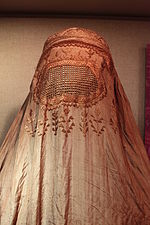புரூக்கா
புரூக்கா உடலை முற்றிலும் மறைத்து சில இஸ்லாமிய நாடுகளில் அணியப்படும் உடை ஆகும். கண்கள் கூட வலையால் மூடப்படிருக்கும். பெண்கள் தங்களின் உடலை கவர்ச்சியாக காட்டக்கூடாது என்ற இஸ்லாமிய நம்பிக்கைக்கு அமைய இந்த உடை அமைகிறது. மேற்குநாடுகளில் இந்த மாதிரி கட்டுபாடுகள் பெண்ணின் உரிமைக்கு எதிரானது என்ற விமர்சனத்துக்கு உள்ளாகிறது. ஆஸ்திரியா, டென்மார்க், பிரான்சு, பெல்ஜியம், தஜிகிஸ்தான், லாத்வியா,[1] பல்கேரியா,[2] கமரூன்,கொங்கோ, நெதர்லாந்து ,[3] மொரோக்கோ[4][5] இலங்கை.[6] உள்ளிட்ட 14 நாடுகளில் புர்க்கா தடைசெய்யப்பட்டுள்ளது.
நாமுஸ்[தொகு]
முஸ்லீம் பெண்கள் வெளி உலக ஆண்கள் பார்ப்பதிலிருந்து தங்களை பாதுகாக்கும் விதமாக நாமுஸ் என்ற கொள்கை பயன்படுத்தப் படுகிறது.[7][8] நாமுஸ் என்பது ஒரு வகை நெறிமுறை, நல்லொழுக்கம் சாரந்தது. இது மத்திய கிழக்கு நாடுகளில் பின்பற்றப்படுகிறது. நாமுஸ் என்பது "மரியாதை" என மொழிபெயர்க்கப்பட்டுள்ளது.
பல்வேறு நாடுகளில் புர்கா பயன்பாடு[தொகு]
இந்தியா[தொகு]
இந்தியாவில் முசுலிம்கள் வசிக்கும் பகுதிகளில் புர்கா அதிகமாக பயன்படுத்தப்படுகிறது.[9] பெண்களின் வயதை பொறுத்து புர்கா அணிவது மாறுபடுகிறது.[10]திருமணமாகாத பெண்கள் அதிகம் புர்கா அணிகின்றனர்.திருமணமான பின் அது கணவன் மற்றும் அந்த பெண்ணின் விருப்பத்தை பொறுத்து உள்ளது.[11]
புர்கா அணிவது தடைசெய்துள்ள நாடுகள்[தொகு]
- நெதர்லாந்து நாட்டில் சூன், 2018 முதல் கல்வி நிலையங்கள், மருத்துவமனைகள்களிலும் மற்றும் பொதுப் போக்குவரத்தைப் பயன்படுத்தும் போதும் முகத்தை மட்டும் முழுவதுமாக மூடும் புர்காக்களை தடை செய்து சட்டம் இயற்றியுள்ளது.
- ஜெர்மனி நாட்டில் புர்காவுக்கு எதிரான சட்டம் இல்லை என்றாலும், வாகனம் ஓட்டும்போது முகத்தை மறைப்பது சட்டவிரோதமானது. ஜெர்மனி நாடாளுமன்றத்தின் கீழவை உறுப்பினர்கள், நீதிபதிகள், வீரர்கள் மற்றும் அரசாங்க ஊழியர்களுக்கு மட்டும் தடைக்கு ஒப்புதல் அளித்தது. இங்கு முகம் முழுவதையும் மறைக்கும் பெண்கள், தேவைப்படும் போது முகத்தைக் காட்டுவதும் கட்டாயமாக்கப்பட்டுள்ளது.
- ஆஸ்திரியா நாட்டில் அக்டோபர் 2017 முதல் பள்ளிகள் மற்றும் நீதிமன்றங்கள் போன்ற பொது இடங்களில் முகத்தை மூடுவது தடை செய்யப்பட்டுள்ளது.
- நார்வே நாட்டில் சூன் 2018 இல் இயற்றப்பட்ட சட்டம் கல்வி நிறுவனங்களில் முகத்தை மறைக்கும் ஆடைகள் அணிவதைத் தடை செய்கிறது.
இதனையும் காண்க[தொகு]
மேற்கோள்கள்[தொகு]
- ↑ "A European government has banned Islamic face veils despite them being worn by just three women". 21 April 2016. பார்க்கப்பட்ட நாள் 1 February 2017.
- ↑ "Bulgaria the latest European country to ban the burqa and [niqab in public places]". 30 September 2016. Smh.com.au: accessed 5 December 2016.
- ↑ Halasz; McKenzie, Stephanie; Sheena (27 June 2018). "The Netherlands introduces burqa ban in some public spaces". CNN. CNN. https://edition.cnn.com/2018/06/27/europe/netherlands-partial-burqa-ban-intl/index.html. பார்த்த நாள்: 9 August 2018.
- ↑ Phillips, Tom (13 January 2015). "China bans burqa in capital of Muslim region of Xinjiang". The Telegraph. The Telegraph. https://www.telegraph.co.uk/news/worldnews/asia/china/11342070/China-bans-burqa-in-capital-of-Muslim-region-of-Xinjiang.html. பார்த்த நாள்: 9 August 2018.
- ↑ "Morocco 'bans sale of the burka'" (in en-GB). 2017-01-10. https://www.bbc.com/news/world-africa-38574457.
- ↑ "Covering the face banned from tomorrow". Daily Mirror.
- ↑ Werner Schiffauer, Die Gewalt der Ehre. Erklärungen zu einem deutsch-türkischen Sexualkonflikt. ("The Force of the Honour"), Suhrkamp: Frankfurt am Main, 1983. ISBN 3-518-37394-3.
- ↑ Dilek Cindoglu, "Virginity tests and artificial virginity in modern Turkish medicine", pp. 215–228, in Women and sexuality in Muslim societies, P. Ýlkkaracan (Ed.), Women for Women's Human Rights, Istanbul, 2000.
- ↑ Suad Joseph, Afsaneh Najmabadi (9 July 2011). Encyclopedia of Women & Islamic Cultures: Family, Law, and Politics. Brill Publishers. https://books.google.com/books?id=4Uyypm6T7ZsC&pg=PA203&dq=burqa+india&hl=en&ei=bucXTpPdMozrgQfjs6kV&sa=X&oi=book_result&ct=result&resnum=1&ved=0CCgQ6AEwADgK#v=onepage&q=burqa%20india&f=false. "The burqá is common in India and Pakistan and a girl is usually required to use it from the age of nine or ten."
- ↑ Jain, Simmi (9 July 2011). Encyclopaedia of Indian Women Through the Ages: Modern India. Kalpaz Publications. https://books.google.com/books?id=JbCKTfEmppsC&pg=PA267&dq=burqa+india&hl=en&ei=BNsXTqXpDZOasAPd7tTxDQ&sa=X&oi=book_result&ct=result&resnum=9&ved=0CFYQ6AEwCA#v=onepage&q&f=false. "The wearing of Burqa was not seen in the rural areas although the majority observed complete purdah whereas in the old Delhi area from where the urban data was collected, ' Burqa ' clad women were quite frequently seen in the markets and other places, as also women without a Burqa."
- ↑ Weigl, Constanze (9 July 2011). Reproductive Health Behavior and Decision-Making of Muslim Women. LIT Verlag Münster. https://books.google.com/books?id=ZHHtWL7VK14C&pg=PA78&dq=burqa+india&hl=en&ei=hd0XTs-3L5S6sAPP7rjZDQ&sa=X&oi=book_result&ct=result&resnum=4&ved=0CD4Q6AEwAw#v=onepage&q=burqa%20india&f=false. "The obligation of a woman to wear a burqa is dependent on her age, as Moazam, one of my key informants, explained to me; a woman with gown-up children has not necessarily to wear a burqa. Young, unmarried women or young, married women in their first years of marriage, however, are obliged to wear it. In this situation a husband usually decides if his wife should continue to wear a burqa after marriage or not. In Nizamuddin Basti girls usually started to wear a burqa when they were around 16 years old and became fecund."


